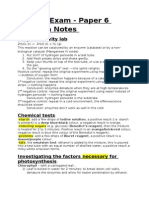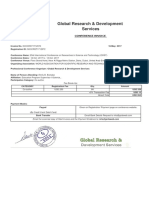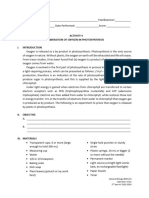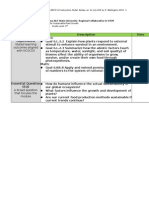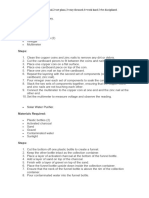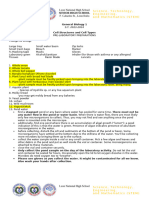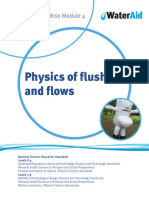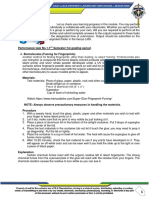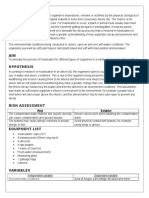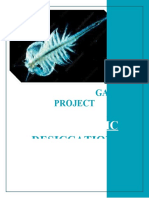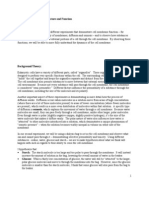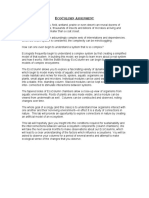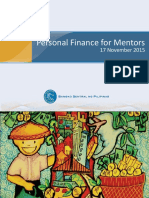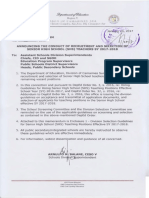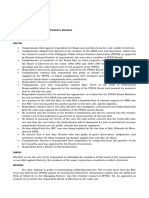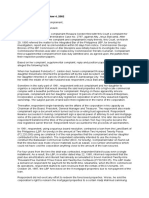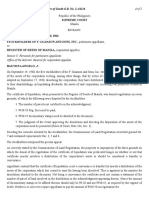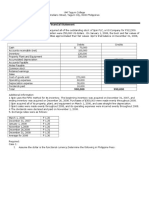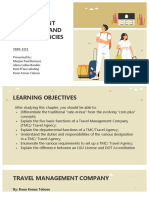Winogradsky Column
Winogradsky Column
Uploaded by
MaryroseCopyright:
Available Formats
Winogradsky Column
Winogradsky Column
Uploaded by
MaryroseOriginal Description:
Copyright
Available Formats
Share this document
Did you find this document useful?
Is this content inappropriate?
Copyright:
Available Formats
Winogradsky Column
Winogradsky Column
Uploaded by
MaryroseCopyright:
Available Formats
WINOGRADSKY COLUMN: ECOSYSTEM IN A BOTTLE
Bacteria and Archaea are the most diverse and numerous organisms on Earth. They are also considered
to be the most ancient forms of life. The two major groups of bacteria exhibit various types of metabolic
mechanismsoxygenic and anoxygenic photoautotrophy, chemoautotrophy, and photoheterotrophy.
They also play an important role in cycling elements (HHMI, 2012).
In this activity, students will be able to:
1. design and/or create their own layers of ecosystem in a bottle (Winogradsky column) taking
into consideration the biotic and abiotic factors
2. explain the roles of biotic and abiotic factors in an ecosystem
3. discuss the effects of changes in the abiotic factors on an ecosystem
Materials
Clear plastic bottles
Trowel for digging sediment samples
Water
Bucket or any large container
Plastic cups
Funnel
Labeling tape
Plastic wrap
plastic disposable containers
permanent marker
shredded newspaper
eggs
large mixing spoon
graduated cylinder
sediment sample
rubber bands
Procedure:
1. Students will be grouped into four (4). Each group will have two plastic disposable containers.
2. Depending on the components selected, the container may be labeled one of the following:
a. control column: sediment + water
b. shredded newspaper (SN) column: sediment +water + shredded newspaper
c. egg yolk (EY) column: sediment + water + egg yolk
d. SN + EY column: sediment + water + SN + EY
3. Add 1.5 cups of sediment into plastic disposable containers.
a. For the control column:
Mix the sediment sample thoroughly. Make sure to remove any large debris such as
leaves, rocks or sticks. Slowly mix in water (either the water you collected or tap water)
until the mixture has the consistency of a milk shake.
DOST-SEIProject STARRSH2015
Page 1 of 2
b. For the SN column:
Add cup of shredded newspaper (loosely packed) to the sediment and mix with a
mixing spoon or trowel.
c. For the EY column:
Add the yolk of an egg (raw is best) to the sediment in the container labeled EY and
mix with a mixing spoon or trowel. If using hard-boiled eggs, crumble the yolks.
d. For the SN + EY column:
Add both nutrients as described in steps b and c.
4. Mix the sediment sample thoroughly. Make sure to remove any large debris such as leaves, rocks or
sticks. Slowly mix in water (either the water you collected or tap water) until the mixture has the
consistency of a milk shake.
5. Using a large spoon, slowly add approximately 1 cup of the mixture to the appropriately labeled
plastic column (bottle). You may wish to use a funnel to add the sediment mixture. As you add
the sample, tap the column on a counter or table to release any trapped air in the column. The
sediment should fill to of the column.
6. Add water from the sediment collection source (or tap water) on top of the sediment until there is a
2-cm layer of water on the surface. (There should be air at the top of the column.)
7. Place the lid on each column and turn the lid a turn. DO NOT tighten the lid! If you cut the bottle
top, place plastic wrap over your column and hold the wrap in place with a rubber band.
8. Place all four columns in a well-lit space such as a windowsill.
9. Using a camera or phone, take a photograph of the columns to document week 0 of the experiment.
Take weekly photographs of the columns. Each column will be observed for up to 8 weeks.
Guide Questions
1. What are the materials you included in your column?
2. Which of the materials are living?
3. Which of the materials are non-living?
4. Will the columns produce similar layers and/or population of microbes? Why or why not?
*5. How many colors/layers did you observe each week?
*6. What do these colors/layers indicate?
*7. How do these layers form?
Reference:
Howard Hughes Medical Institute. (2012). Winogradsky Column. Available from:
biointeractive@hhmi.org.
DOST-SEIProject STARRSH2015
Page 2 of 2
You might also like
- Chapter 2 Advance Acctg.Document20 pagesChapter 2 Advance Acctg.Clarize R. Mabiog82% (11)
- MHICA Axial SwageDocument42 pagesMHICA Axial SwageSwampfootNo ratings yet
- Biology Igcse ExperimentsDocument15 pagesBiology Igcse ExperimentsZoe Nyawira75% (4)
- InvoiceDocument1 pageInvoiceMaryroseNo ratings yet
- Report HR MGMT Jan2005Document89 pagesReport HR MGMT Jan2005MaryroseNo ratings yet
- Hyundai - Blue Print Tech Article EPS Part1Document4 pagesHyundai - Blue Print Tech Article EPS Part1Ahmed I. EltaherNo ratings yet
- Winogradsky LabDocument9 pagesWinogradsky Labannie.termaatNo ratings yet
- P6 - Bottle MicrocosmDocument7 pagesP6 - Bottle MicrocosmWilson CheungNo ratings yet
- Winogradsky Columns: Microbial Ecology in The ClassroomDocument9 pagesWinogradsky Columns: Microbial Ecology in The ClassroomormattNo ratings yet
- Preparing Ozone Test Strips (Aka Schoenbein Papers)Document7 pagesPreparing Ozone Test Strips (Aka Schoenbein Papers)Old McDonaldNo ratings yet
- Lab Activity 4 Liberation of Oxygen in PhotosynthesisDocument4 pagesLab Activity 4 Liberation of Oxygen in PhotosynthesisNathaniel UbaNo ratings yet
- Eco-Column Lab: What You'll Need To Build The Eco-ColumnsDocument3 pagesEco-Column Lab: What You'll Need To Build The Eco-ColumnsjohnosborneNo ratings yet
- APES Eco-ColumnsDocument6 pagesAPES Eco-ColumnsjohnosborneNo ratings yet
- Trisha Mae de Vera Experiment 1 ECOCOLUMN PROJECTDocument5 pagesTrisha Mae de Vera Experiment 1 ECOCOLUMN PROJECTTrisha De VeraNo ratings yet
- Laboratory 8: Banana Lab: Ripening Bananas: What's Happening and Can We Control It?Document6 pagesLaboratory 8: Banana Lab: Ripening Bananas: What's Happening and Can We Control It?ஜா டாNo ratings yet
- Diffusion and Osmosis LabDocument12 pagesDiffusion and Osmosis LabIsland VitalNo ratings yet
- Maximizing and Collecting Algae Biomass For Fuel ProductionDocument5 pagesMaximizing and Collecting Algae Biomass For Fuel ProductionLuis LopezNo ratings yet
- Bottle Ecosystem by Jessica Appelman Grade: 3 Subject: Science TeksDocument6 pagesBottle Ecosystem by Jessica Appelman Grade: 3 Subject: Science Teksapi-353252926No ratings yet
- Law of Conservation Mass - LabDocument4 pagesLaw of Conservation Mass - LabcdeeterNo ratings yet
- Brine Shrimp Ecology by Michael Dockery and Stephen TomkinsDocument2 pagesBrine Shrimp Ecology by Michael Dockery and Stephen TomkinsZicoNo ratings yet
- Riverside MS StemDocument7 pagesRiverside MS Stemtmlittle3038No ratings yet
- Cscott SciencecircusDocument21 pagesCscott Sciencecircusapi-295082759No ratings yet
- Exercise1 DEMONSTRATION OF OSMOSISDocument5 pagesExercise1 DEMONSTRATION OF OSMOSISKristel Bliss RomanoNo ratings yet
- A Teacher Demonstration: The Biosphere BottleDocument5 pagesA Teacher Demonstration: The Biosphere BottleHeziel VillaflorNo ratings yet
- Biobottle ProjectDocument14 pagesBiobottle ProjectNoah ArchibaldNo ratings yet
- Science Fair Project - Grade 10 - Group 1 PDFDocument9 pagesScience Fair Project - Grade 10 - Group 1 PDFAngie L.MNo ratings yet
- Inquiry Based LPDocument14 pagesInquiry Based LPRandy RanaNo ratings yet
- Activity For Saturday STEM 12Document2 pagesActivity For Saturday STEM 12Alvin PaboresNo ratings yet
- Project Base LearningDocument3 pagesProject Base LearningAMERUDIN M. ABDULAHNo ratings yet
- Osmosis Mini Lesson Fall 2015Document6 pagesOsmosis Mini Lesson Fall 2015TeacherNo ratings yet
- Homemade BatteryDocument4 pagesHomemade Batterysiddharth.yt444No ratings yet
- Cell Structure and Cell Types LaboratoryDocument13 pagesCell Structure and Cell Types LaboratoryJoshua CanonicatoNo ratings yet
- Mushroom PDFDocument4 pagesMushroom PDFfluto74No ratings yet
- Eco Bottle ProjectDocument4 pagesEco Bottle ProjectRae Yum-SohNo ratings yet
- Yeast Cellular Respiration Labfin-2Document7 pagesYeast Cellular Respiration Labfin-2Nabeel UddinNo ratings yet
- Physics of Flushes and FlowsDocument4 pagesPhysics of Flushes and Flowsyu yanNo ratings yet
- Biodegradable PlasticDocument24 pagesBiodegradable PlasticAin SoberanoNo ratings yet
- Ecocolumn InstructionsDocument10 pagesEcocolumn InstructionsEmminaNo ratings yet
- Wino Grad Sky ColumnDocument10 pagesWino Grad Sky ColumnCaesar OweituNo ratings yet
- Microscope Lab Pro Vs EukDocument5 pagesMicroscope Lab Pro Vs Eukapi-304326920No ratings yet
- Unit 2 AP Lab #3Document10 pagesUnit 2 AP Lab #3laraNo ratings yet
- Mesocosm Lab ActivityDocument2 pagesMesocosm Lab ActivityPastel PepeNo ratings yet
- Document 00Document9 pagesDocument 00Anonymous P2RUSMdchRNo ratings yet
- Biogas Our of Scrap FoodDocument3 pagesBiogas Our of Scrap FoodNet VillanuevaNo ratings yet
- The Laboratory Activities of Natural Science: For Vocational High Schools (SMK) Class XiDocument12 pagesThe Laboratory Activities of Natural Science: For Vocational High Schools (SMK) Class XiirhasNo ratings yet
- Steps On How To Culture Bacteria For Collection of Data in A StudyDocument2 pagesSteps On How To Culture Bacteria For Collection of Data in A StudyEd JilNo ratings yet
- 1.0 Magic Science: ObjectivesDocument62 pages1.0 Magic Science: ObjectivesSulhaniza Zainal AbidinNo ratings yet
- PT1 FG Bio1 22Document5 pagesPT1 FG Bio1 22Zwen ZyronneNo ratings yet
- ExperimentDocument5 pagesExperimentAditya VermaNo ratings yet
- Black Magic and Baloon DemoDocument3 pagesBlack Magic and Baloon DemojowieNo ratings yet
- .Biology Investigatory Project.Document18 pages.Biology Investigatory Project.Geetali MadkaikerNo ratings yet
- Lab 5 Cell Membrane Structure and Function FinalDocument12 pagesLab 5 Cell Membrane Structure and Function Finalannekemp100% (2)
- 5 Biology Experiments For Secondary SchoolDocument22 pages5 Biology Experiments For Secondary SchoolScribdTranslationsNo ratings yet
- Kimia AnalisisDocument75 pagesKimia AnalisisQonita NitaNo ratings yet
- Laboratory ReportDocument2 pagesLaboratory ReportSamanta TorresNo ratings yet
- P3 Lab Activities (July)Document7 pagesP3 Lab Activities (July)hashimmsNo ratings yet
- Diffusion LabDocument10 pagesDiffusion LabDalena HuynhNo ratings yet
- ECOCOLUMN InstructionsDocument11 pagesECOCOLUMN InstructionsSofia ValenciaNo ratings yet
- Micro PrefinalsDocument24 pagesMicro PrefinalsMary Vinneizia CelecioNo ratings yet
- Ticket-In - Class Task 1 PreparationDocument4 pagesTicket-In - Class Task 1 PreparationGianni RaffaNo ratings yet
- HCSO2910023PGPDocument19 pagesHCSO2910023PGPMarlene NiyomuhozaNo ratings yet
- Bio Plastic Exhibit BoardDocument18 pagesBio Plastic Exhibit BoardAsh PerezNo ratings yet
- Junk Drawer Ecology: 50 Awesome Experiments That Don't Cost a ThingFrom EverandJunk Drawer Ecology: 50 Awesome Experiments That Don't Cost a ThingNo ratings yet
- PerForM For TIPDocument29 pagesPerForM For TIPMaryroseNo ratings yet
- Personal Finance For Mentors: 17 November 2015Document43 pagesPersonal Finance For Mentors: 17 November 2015MaryroseNo ratings yet
- List of CasesDocument9 pagesList of CasesMaryroseNo ratings yet
- Label SF FormsDocument1 pageLabel SF FormsMaryroseNo ratings yet
- Apds PerformDocument16 pagesApds PerformMaryroseNo ratings yet
- Vincentian PhilosophyDocument3 pagesVincentian PhilosophyMaryroseNo ratings yet
- Self-Assessment About CharityDocument4 pagesSelf-Assessment About CharityMaryroseNo ratings yet
- Zalamea vs. Atty. de GuzmanDocument2 pagesZalamea vs. Atty. de GuzmanMaryroseNo ratings yet
- 30 S. 2017Document7 pages30 S. 2017MaryroseNo ratings yet
- Article or Study About Vincentian SpiritualityDocument11 pagesArticle or Study About Vincentian SpiritualityMaryroseNo ratings yet
- Hutchison Vs SbmaDocument2 pagesHutchison Vs SbmaMaryroseNo ratings yet
- Vincentian PhilosophyDocument3 pagesVincentian PhilosophyMaryroseNo ratings yet
- As of Mar 4 Morning Ethics DigestsDocument34 pagesAs of Mar 4 Morning Ethics DigestsMaryroseNo ratings yet
- Mercullo vs. Atty-RamonDocument2 pagesMercullo vs. Atty-RamonMaryrose100% (1)
- Cordon Vs BalicantaDocument11 pagesCordon Vs BalicantaMaryroseNo ratings yet
- People Vs Del RosarioDocument2 pagesPeople Vs Del RosarioMaryroseNo ratings yet
- A. Villatuya Vs TabalingcosDocument7 pagesA. Villatuya Vs TabalingcosMaryroseNo ratings yet
- 006-Stockholders of F. Guanzon and Sons, Inc. vs. Register of Deeds of Manila 6 Scra 373 (1962)Document2 pages006-Stockholders of F. Guanzon and Sons, Inc. vs. Register of Deeds of Manila 6 Scra 373 (1962)wewNo ratings yet
- I. Palad Vs SolisDocument5 pagesI. Palad Vs SolisMaryroseNo ratings yet
- 01-Esqueda v. People GR. No. 170222 June 18, 2009Document12 pages01-Esqueda v. People GR. No. 170222 June 18, 2009MaryroseNo ratings yet
- 02-Lasquite, Et Al. v. Victory Hills Lnc. GR. No. 175375 June 23, 2009Document6 pages02-Lasquite, Et Al. v. Victory Hills Lnc. GR. No. 175375 June 23, 2009MaryroseNo ratings yet
- 10-REYNOSO, IV vs. CADocument2 pages10-REYNOSO, IV vs. CAMaryrose0% (1)
- Primary Side Power Switcher For Off-Line SMPS AP3968/69/70/70SDocument15 pagesPrimary Side Power Switcher For Off-Line SMPS AP3968/69/70/70SSandeep MohanNo ratings yet
- M (1 1)Document557 pagesM (1 1)Anonymous lfw4mfCm100% (1)
- PARTNERSHIP AGREEMENT Located in The State of TennesseeDocument12 pagesPARTNERSHIP AGREEMENT Located in The State of TennesseenowayNo ratings yet
- Promotion Strategy of IKIO Coffee As A Tourism Spot in Madiun CityDocument48 pagesPromotion Strategy of IKIO Coffee As A Tourism Spot in Madiun CityDean FaizNo ratings yet
- Mas DocumentsDocument12 pagesMas DocumentsLorie Grace LagunaNo ratings yet
- (Creditcoin) White PaperDocument31 pages(Creditcoin) White PaperMantas JeyNo ratings yet
- Sacraments: The Seven ActivityDocument7 pagesSacraments: The Seven ActivityKori-Lyn PalmieriNo ratings yet
- SSF Hammer Set Socket Anchor Drop in Anchor PDFDocument1 pageSSF Hammer Set Socket Anchor Drop in Anchor PDFMauricio SosaNo ratings yet
- Reactive Dyeing of CottonDocument61 pagesReactive Dyeing of CottonTuan Nguyen Minh100% (3)
- Checklist For GRS - RCS GOTS - OCS CertificationDocument8 pagesChecklist For GRS - RCS GOTS - OCS Certificationm f velatiNo ratings yet
- Fenixway Field Reporte - 295 80R22.5 Valor 99Document5 pagesFenixway Field Reporte - 295 80R22.5 Valor 99SergioNo ratings yet
- KAM SU 8 3000 Datasheet 7.10 FinalDocument6 pagesKAM SU 8 3000 Datasheet 7.10 Finalf20213161No ratings yet
- Water WaterDocument2 pagesWater WaterHannah CorpuzNo ratings yet
- MB0044 - Production and Operations Management Assignment Set - 1Document8 pagesMB0044 - Production and Operations Management Assignment Set - 1Ravi GuptaNo ratings yet
- The Nursing ProcessDocument8 pagesThe Nursing ProcessSonia G. Ortiz100% (1)
- HT Ancamine 2143Document6 pagesHT Ancamine 2143rosarioNo ratings yet
- Perpetuity Annuity 2Document50 pagesPerpetuity Annuity 2baldonangelie29No ratings yet
- Entrance Exam Question PaperDocument4 pagesEntrance Exam Question PaperJanhvi Kishori ThakkarNo ratings yet
- Samsung sm-r210 PDFDocument51 pagesSamsung sm-r210 PDFJavier RuedasNo ratings yet
- Case Study of Electrical AccidentDocument5 pagesCase Study of Electrical AccidentSr. DEENo ratings yet
- Travel Agency ManagementDocument47 pagesTravel Agency ManagementKatherine BarretoNo ratings yet
- Assignment-1 QSM 506 March 2012-AFO-FinalDocument2 pagesAssignment-1 QSM 506 March 2012-AFO-FinalMuhammad GhazaliNo ratings yet
- List of State and Union Territory Capitals in IndiaDocument67 pagesList of State and Union Territory Capitals in Indiaanon_8049111No ratings yet
- Sugar FactoryDocument41 pagesSugar Factory4PS19AU411 Syeda Soubiya MuskanNo ratings yet
- The Role of Reserve Bank of India in The Economy and Social DevelopmentDocument25 pagesThe Role of Reserve Bank of India in The Economy and Social DevelopmentFranxx DarlingNo ratings yet
- Corrected Proposal Corrected.Document10 pagesCorrected Proposal Corrected.Preeti ChouhanNo ratings yet
- Aurelio 2013Document25 pagesAurelio 2013Ralf PayongaNo ratings yet


